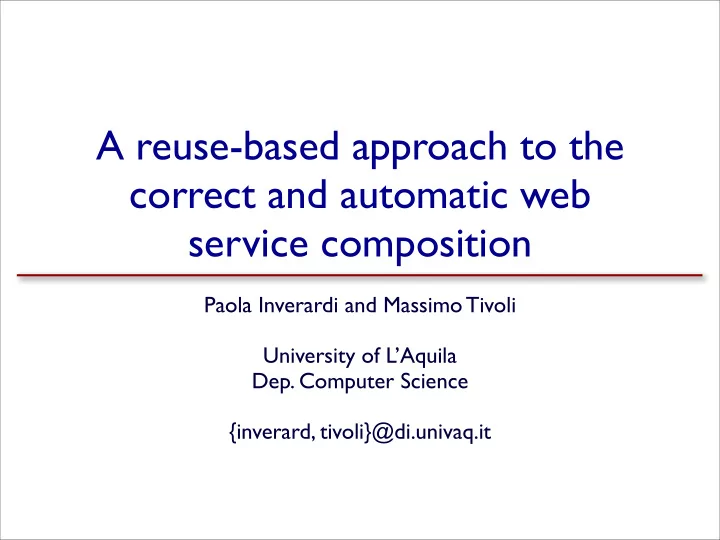

A reuse-based approach to the correct and automatic web service composition Paola Inverardi and Massimo Tivoli University of L’Aquila Dep. Computer Science {inverard, tivoli}@di.univaq.it
Application domain • Distributed business processes that cross organizational boundaries • e-Government, e-Commerce, e-Banking • They can be implemented by performing service composition • i.e., as novel services that correctly orchestrate existing services • Handcrafted service composition is supported but it is still a difficult activity
Our goal • Automatic service composition • to build a new service as an automatic and correct composition of existing services • based on our previous work on component assembly (the SYNTHESIS tool) • web services (WSs)
Setting the context • A centralized repository • e.g., UDDI registry • Each existing WS publishes its complete SLS • e.g., WSDL + BPEL in the context of WSs • The architect of the new WS specifies its partial SLS
Method’s overview existing web services SYNTHESIS WS1 (for web services) LTS1 (WSDL + . BPEL) . . . . composite service . . implementation . . . CWS WSn . (WSDL + LTScws (WSDL + LTSn BPEL) BPEL) composite service specification CWS (WSDL + operation partial correspondence BPEL) vectors
Explanatory example... continuing • 2 existing WSs: LIB and PAY • LIB is an old electronic library • PAY provides an on-line payment capability • 1 new WS to be built: CWS • CWS is a new electronic library providing an on- line payment capability
Explanatory example... continuing • INPUT 1 : WSDL + BPEL spec. of PAY
Explanatory example... continuing • INPUT 1 : WSDL + BPEL spec. of PAY WSDL <definitions ... <portType name="PAY_PT"> <operation name="login"> ... </operation> <operation name="logout"> ... </operation> <operation name="pay"> ... </operation> </portType> ... <role name="PAY"> <portType name="PAY_PT"/> </role> <service name="PAY_BP"/> </definitions>
Explanatory example... continuing • INPUT 1 : WSDL + BPEL spec. of PAY WSDL <definitions ... <portType name="PAY_PT"> <operation name="login"> ... </operation> <operation name="logout"> ... </operation> <operation name="pay"> ... </operation> </portType> ... <role name="PAY"> <portType name="PAY_PT"/> </role> <service name="PAY_BP"/> </definitions>
Explanatory example... continuing • INPUT 1 : WSDL + BPEL spec. of PAY WSDL <definitions ... <portType name="PAY_PT"> <operation name="login"> ... </operation> <operation name="logout"> ... </operation> <operation name="pay"> ... </operation> </portType> ... <role name="PAY"> <portType name="PAY_PT"/> </role> <service name="PAY_BP"/> </definitions>
Explanatory example... continuing • INPUT 1 : WSDL + BPEL spec. of PAY WSDL <definitions ... <portType name="PAY_PT"> <operation name="login"> ... </operation> <operation name="logout"> ... </operation> <operation name="pay"> ... </operation> </portType> ... <role name="PAY"> <portType name="PAY_PT"/> </role> <service name="PAY_BP"/> </definitions>
Explanatory example... continuing • INPUT 1 : WSDL + BPEL spec. of PAY WSDL BPEL <process name="PAY_PROCESS" ... <partners> <partner name="customer" ... /> <definitions ... <partner name="book_vendor" ... /> <portType name="PAY_PT"> </partners> ... <operation name="login"> ... </operation> <sequence> <operation name="logout"> ... </operation> <receive name="authentication" partner="customer" <operation name="pay"> ... </operation> portType="PAY_PT" operation="login" .../> </portType> ... <while ...> ... <role name="PAY"> <receive name="payment" partner="customer" <portType name="PAY_PT"/> portType="PAY_PT" operation="pay" .../> </role> </while> <service name="PAY_BP"/> <receive name="exit" partner="customer" </definitions> portType="PAY_PT" operation="logout" .../> </sequence> </process>
Explanatory example... continuing • INPUT 1 : WSDL + BPEL spec. of PAY WSDL BPEL <process name="PAY_PROCESS" ... <partners> <partner name="customer" ... /> <definitions ... <partner name="book_vendor" ... /> <portType name="PAY_PT"> </partners> ... <operation name="login"> ... </operation> <sequence> <operation name="logout"> ... </operation> <receive name="authentication" partner="customer" <operation name="pay"> ... </operation> portType="PAY_PT" operation="login" .../> </portType> ... <while ...> ... <role name="PAY"> <receive name="payment" partner="customer" <portType name="PAY_PT"/> portType="PAY_PT" operation="pay" .../> </role> </while> <service name="PAY_BP"/> <receive name="exit" partner="customer" </definitions> portType="PAY_PT" operation="logout" .../> </sequence> </process>
Explanatory example... continuing • INPUT 1 : WSDL + BPEL spec. of PAY WSDL BPEL <process name="PAY_PROCESS" ... <partners> <partner name="customer" ... /> <definitions ... <partner name="book_vendor" ... /> <portType name="PAY_PT"> </partners> ... <operation name="login"> ... </operation> <sequence> <operation name="logout"> ... </operation> <receive name="authentication" partner="customer" <operation name="pay"> ... </operation> portType="PAY_PT" operation="login" .../> </portType> ... <while ...> ... <role name="PAY"> <receive name="payment" partner="customer" <portType name="PAY_PT"/> portType="PAY_PT" operation="pay" .../> </role> </while> <service name="PAY_BP"/> <receive name="exit" partner="customer" </definitions> portType="PAY_PT" operation="logout" .../> </sequence> </process>
Explanatory example... continuing • INPUT 1 : WSDL + BPEL spec. of PAY WSDL BPEL <process name="PAY_PROCESS" ... <partners> <partner name="customer" ... /> <definitions ... <partner name="book_vendor" ... /> <portType name="PAY_PT"> </partners> ... <operation name="login"> ... </operation> <sequence> <operation name="logout"> ... </operation> <receive name="authentication" partner="customer" <operation name="pay"> ... </operation> portType="PAY_PT" operation="login" .../> </portType> ... <while ...> ... <role name="PAY"> <receive name="payment" partner="customer" <portType name="PAY_PT"/> portType="PAY_PT" operation="pay" .../> </role> </while> <service name="PAY_BP"/> <receive name="exit" partner="customer" </definitions> portType="PAY_PT" operation="logout" .../> </sequence> </process>
Recommend
More recommend